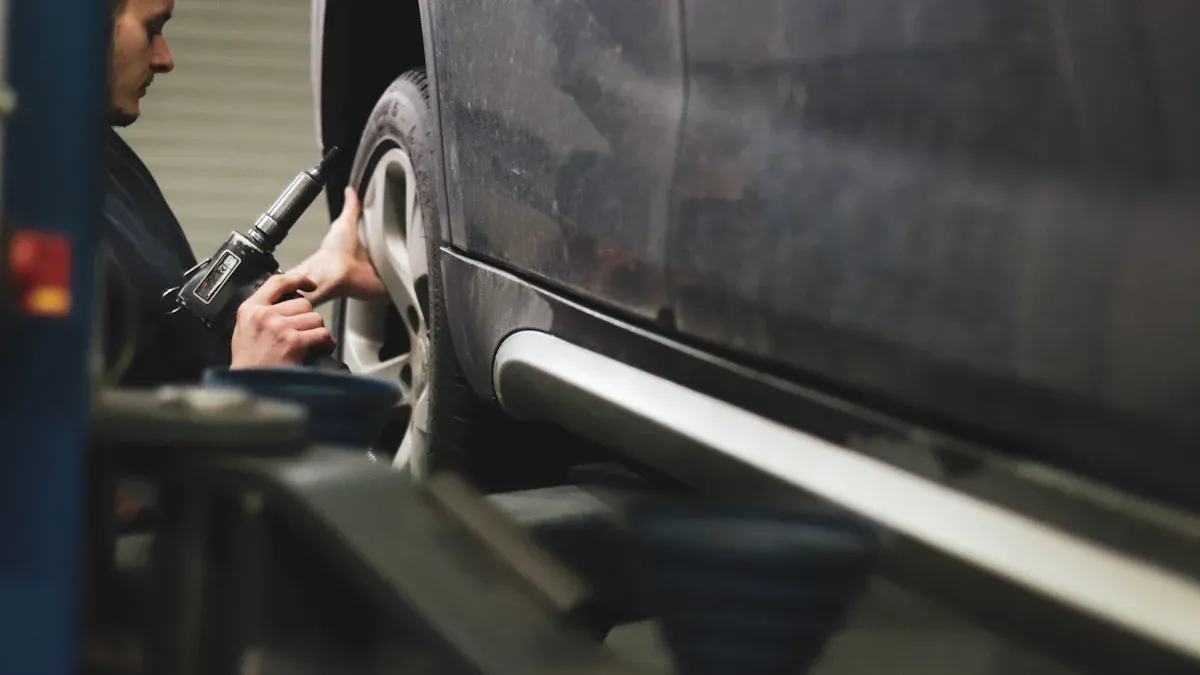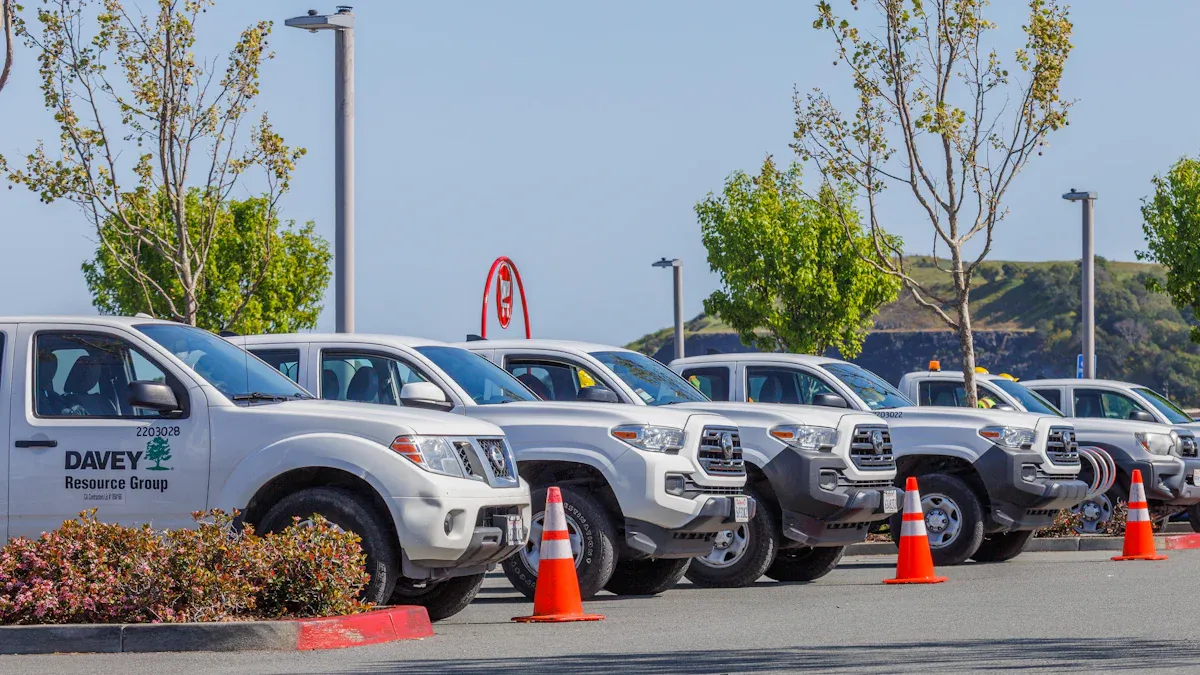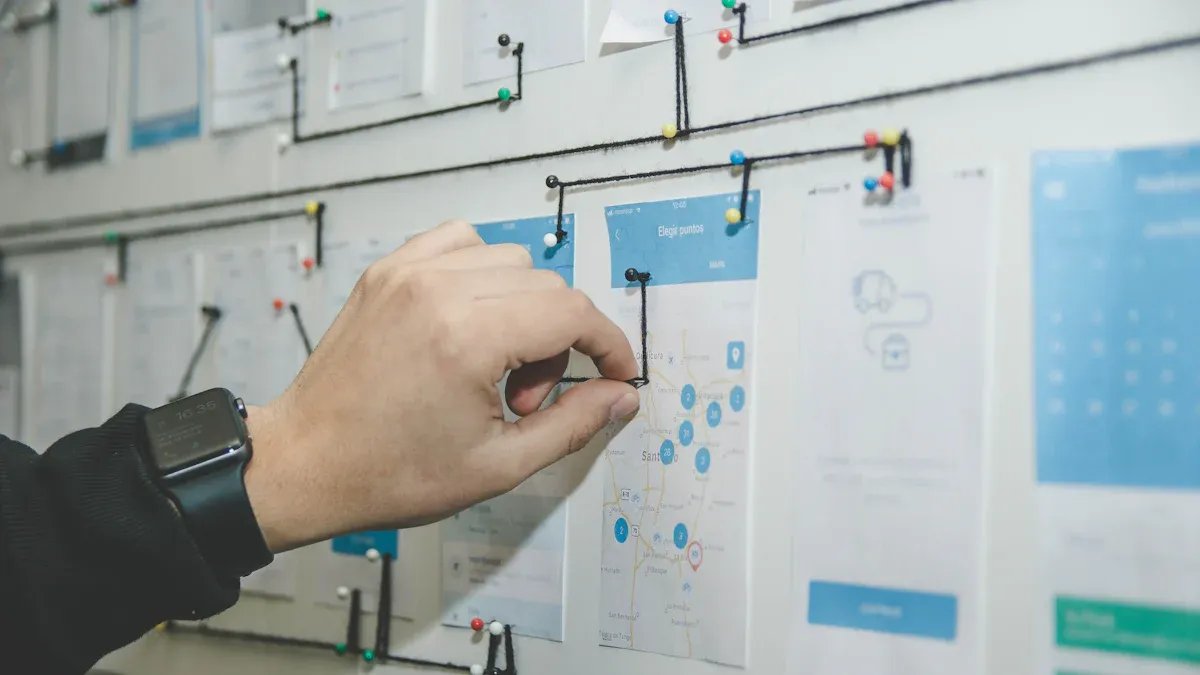
Tire tread depth is very important for vehicle safety and performance. If the tread is too low, it can cause serious accidents. Statistics show that around 9.09% of vehicle crashes are due to tire problems. A tire tread scanner is a helpful tool for checking tires closely. It helps you find tread wear and possible issues before they get worse. Regularly checking tread not only makes fleet safety better but also lowers maintenance costs. This keeps your vehicles dependable on the road.
Ključne ugotovitve
Check tire tread depth often. This helps keep you safe and lowers accident risks from worn tires.
Uporabite skener globine pnevmatik for quick and accurate checks. This helps find tire issues early and saves money on repairs.
Make sure tires are properly inflated. Rotate them every 5,000 to 8,000 miles for even wear and longer life.
Avoid mistakes like measuring inconsistently and ignoring manufacturer rules. This can lead to expensive repairs and unsafe conditions.
Add tire tread data to fleet management systems. This helps you make better maintenance choices and keeps your fleet dependable.
Importance of Tire Tread Inspection

Safety Impact
Tire tread depth is very important for vehicle safety. When the tread gets too low, accidents can happen more often. Worn tires make it harder to stop, especially on wet roads. For example, tires with a tread depth of 2/32 inches need over 50% more distance to stop than new tires. This longer stopping distance can mean the difference between avoiding an accident and crashing.
Tukaj je nekaj common reasons for tire-related accidents in commercial fleets:
Cause Category | Specific Causes | Pojasnilo |
|---|---|---|
Poor Vehicle Maintenance | Worn or bad tires | Tires that are not in good shape raise accident risk; keeping up with maintenance helps avoid problems. |
Equipment Failure | Tire blowouts | Mechanical issues like blowouts can cause loss of control or make it hard to stop in time. |
Improper Cargo Loading | Overloaded or unevenly loaded cargo | Too much weight or shifting cargo can lead to tire blowouts or rollovers, raising accident risk. |
These reasons show why regular tire inspections are important. By keeping your fleet’s tire tread depth in good shape, you can greatly lower the chances of accidents.
Cost Efficiency
Keeping the right tire tread depth is not only about safety; it also affects your budget. Regular checks and good maintenance can save your fleet a lot of money each year. For instance, one fleet cut its tire replacement costs by 20% just by watching tire conditions. This smart approach stops tires from wearing out too soon and avoids expensive emergency replacements.
The average cost of an emergency flat tire for fleets is about $338.42. This includes driver downtime, vehicle downtime, and tire change costs. By spending on regular tread depth tests and maintenance, you can dodge these surprise costs and make your fleet run better.
Also, good tire care makes tires last longer and helps fuel efficiency. Programs like the WEX savings network give special discounts that lower tire-related costs even more. By focusing on tire tread inspections, you not only boost safety but also save a lot of money for your fleet.
Uporaba skenerja profila pnevmatike

Preparation for Scanning
Before you start checking the tires, you need to prepare well. This helps you get accurate results. Follow these steps for a smooth scanning process:
Charge the Device: Make sure your tire tread scanner has a full battery. A low battery can stop the scanning.
Clean the Camera Lens: Wipe the camera lens to get rid of dirt or smudges. A clean lens gives clear images and better readings.
Position the Vehicle: Park the vehicle in a bright area where all four tires are easy to reach. Stay away from spots with glare or shadows that can mess up the scan.
Use On-Screen Guidance: If your scanner shows guides on the screen, use them. These guides help you align the camera right for sidewall or tread scans.
By doing these steps, you will have a good tire tread scanning session.
Scanning Process
After getting the vehicle and scanner ready, you can start scanning. Here’s how to use the tire tread scanner step by step:
Open the Scanning App: Start the scanning app on your smart device.
Scan the Tire: Move the device over the tire tread to take a picture of the tire profile. Make sure to cover the whole tread area for complete data.
Review Results: Check the results shown by the app right away. This helps you see the tire condition quickly.
Generate Reports: After scanning, get a detailed digital report for each tire. This report can be used for record-keeping or client data management.
The skener globine pnevmatik uses smart technology to measure tread depth and find wear patterns. It shows a visual, color-coded chart that tells you safety levels. This helps you know when tires need to be replaced. This technology also works with scanning tire identification data and fits into commercial tire management systems.
Understanding the data from your tire tread scanner is important for making smart maintenance choices. Here are some key insights you can get from the data:
The scanner measures tread depth and finds wear patterns.
You get useful information like remaining tread depth, uneven wear, and possible damage.
Real-time reporting gives you current tire condition details.
This data helps you plan maintenance, so you know when to replace tires.
You can find alignment or suspension issues early by looking at wear patterns.
Using the tire tread scanner improves safety by spotting tire problems before they become serious. It also helps you save money by making tires last longer and avoiding emergency repairs. By adding this data to your fleet management systems, you can make smart decisions about tire rotations, replacements, and how well your tire program works.
Benefits of Mobile Tire Scanning
Efficiency and Accuracy
Mobile tire scanning has many benefits compared to old inspection methods. You can get better accuracy with mobile tire tread scanners. They use smart AI and computer vision technology. These tools make exact 3D models of tire tread depth. This stops mistakes that happen with manual tools. Here are some main benefits:
Faster Inspections: Mobile tire scanning lets you scan tires in seconds. This cuts down on downtime during inspections.
Real-Time Data Capture: You can capture and process data right away. This means you can share tire conditions with your team or customers quickly.
Uporabniku prijazno: These scanners are easy to use. You just point your mobile device camera at the tire to capture the tread.
Cost-Effective: Mobile scanners lower the need for expensive measuring tools. This makes them a smart choice for fleet management.
Recent studies show that 82% of fleet managers still use handheld gauges. These only measure one spot, which can cause mistakes. On the other hand, mobile tire scanning gives steady measurements all around the tire. This helps you find uneven wear patterns easily.
Data Integration
Putting data from mobile tire scanning into your fleet management systems makes things run smoother. The technology works well with your current software. This helps you track tire and vehicle data correctly. Here’s how it works:
Direct Integration: Mobile data capture technology fits into your fleet management systems. You don’t need new devices.
Sledenje v realnem času: You can check tire conditions as they happen. This helps with proactive maintenance and checking compliance.
Reduced Manual Entry: Using OCR technology lets you scan tire data quickly. This cuts down on manual entry mistakes and boosts accuracy.
This integration helps you make better decisions. It gives you insights into tire health and maintenance needs. By using mobile tire scanning, you can use tires better, save money, and keep vehicles safe.
Pogoste napake, ki se jim je treba izogniti
Inconsistent Measurements
Not measuring tire tread depth correctly can cause safety problems and higher maintenance costs. Here are some mistakes to avoid:
Only using Tire Pressure Monitoring Systems (TPMS), which might miss low pressure.
Ignoring uneven wear from misalignment or suspension problems.
Missing foreign objects stuck in tires, like nails or screws.
Not keeping tire pressure at the right level as the manufacturer says.
These mistakes can cause uneven wear, blowouts, and more expenses. Checking tire tread depth regularly helps stop these problems. Taking care of tires early saves money on replacements and keeps the fleet running smoothly.
Impact Aspect | Pojasnilo |
|---|---|
Varnost | Low or uneven tire tread reduces grip, makes stopping harder, and raises hydroplaning risk, which can affect vehicle control. |
Stroški vzdrževanja | Tires with uneven tread depths over 2/32nds wear out faster and need to be replaced sooner, raising costs. |
Učinkovitost porabe goriva | Keeping tread in good shape helps lower fuel use, cutting operating costs. |
Tire Lifecycle | Replacing tires early due to uneven wear means they don’t last as long, increasing how often you need to replace them. |
Proactive Maintenance | Changing tires on time and retreading saves money compared to buying new ones. |
Ignoring Guidelines
Not following manufacturer guidelines during tire tread checks can lead to big problems. Here are some important steps to take:
Put a penny with Lincoln’s head upside down between two ribs on the tire.
Check several spots around the tire for uneven wear.
If the tread covers part of Lincoln’s head, the tread depth is safe.
If you can see all of Lincoln’s head, the tread depth is 1/16 inch or less, meaning you need new tires.
Regularly look for signs of aging, uneven tread, or visible damage on tires.
Ignoring these steps can cause blowouts, accidents, and costly downtime. Regular checks find problems early, which helps avoid expensive repairs. By following these steps, you keep drivers safe and follow the rules.
Using a tire tread scanner is very important for fleet safety. Redno preverjanje pnevmatik helps you find problems early, like bad tire pressure and uneven wear. This smart way of doing things can bring big benefits:
Rotating tires every 5,000 to 8,000 miles helps them wear evenly and last longer.
Keeping the right tire pressure stops early wear and dangerous situations.
Finding tire issues early helps you avoid expensive repairs and accidents.
By using tire tread scanning technology, you can make your operations run better and lower maintenance costs. Use this technology to keep roads safer and have a more dependable fleet.
Pogosta vprašanja
What is a tire tread scanner?
A skener globine pnevmatik is a tool that checks how deep the tire tread is and finds wear patterns. It gives you accurate information to help you understand tire condition and make smart maintenance choices.
How often should I inspect tire tread depth?
Priporočamo, da preverite globino profila pnevmatike at least once a month. Regular checks help you spot problems early and keep your fleet safe and performing well.
Can I use a tire tread scanner in different weather conditions?
Yes, you can use a tire tread scanner in many weather conditions. Just make sure the area is bright and free from glare or shadows for the best results.
How does tire tread depth affect fuel efficiency?
Tire tread depth affects fuel efficiency directly. Worn tires create more rolling resistance, which uses more fuel. Keeping the right tread depth helps improve fuel economy and lowers operating costs.
What should I do if my tires show uneven wear?
If your tires have uneven wear, check for alignment or suspension problems. Fixing these issues quickly can stop more damage and help your tires last longer.
Glej tudi
Razumevanje delovanja pametnih senzorjev globine profila pnevmatik






